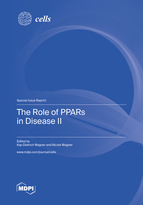The Role of PPARs in Disease II
A special issue of Cells (ISSN 2073-4409). This special issue belongs to the section "Cells of the Cardiovascular System".
Deadline for manuscript submissions: closed (30 September 2022) | Viewed by 60632
Special Issue Editors
Interests: vessel formation in development and disease; transcriptional control; epigenetics; cancer; cardiovascular disease
Special Issues, Collections and Topics in MDPI journals
Interests: PPARs; cancer; development; angiogenesis; transcriptional regulation; tumor angiogenesis; mechanisms of tumor progression; cancer treatment
Special Issues, Collections and Topics in MDPI journals
Special Issue Information
Dear Colleagues,
Peroxisome proliferator-activated receptors (PPARs) are nuclear receptors. They function as ligand-activated transcription factors. They exist in three isoforms, PPARα, PPARβ/δ), and PPARγ. For all PPARs, lipids are endogenous ligands, linking them directly to metabolism. PPARs form heterodimers with retinoic X receptors and, upon ligand binding, modulate gene expression of downstream target genes, depending on the presence of co-repressors or co-activators. This results in a complex, cell-type-specific regulation of proliferation, differentiation, and cell survival. Specific synthetic agonists for all PPARs are available. PPARα and PPARγ agonists are already in clinical use for the treatment of hyperlipidemia and type 2 diabetes, respectively. More recently, PPAR β/δ activation came into focus as an interesting novel approach for the treatment of metabolic syndrome and associated cardiovascular diseases.
In summary, PPARs are linked to metabolic disorders and are interesting pharmaceutical targets. PPARs play important roles in a variety of disorders, e.g., cardiovascular, hepatic, neurological, psychiatric, and immunological diseases, and cancer. We guest-edited a first Special Issue on “The Role of PPARs in Disease” in Cells in 2019–2020. Despite the global health crisis, 11 papers were published in this Special Issue, which have received until now nearly 17,000 views and 112 citations. The impact factor of Cells increased dramatically in the previous year to 6.6.
We hope that this new Special Issue of Cells will bring together the most recent and exciting advances in understanding the various aspects of the action of PPARs, from basic science to applied therapeutic approaches.
Sincerely yours,
Dr. Kay-Dietrich Wagner
Guest Editor
Manuscript Submission Information
Manuscripts should be submitted online at www.mdpi.com by registering and logging in to this website. Once you are registered, click here to go to the submission form. Manuscripts can be submitted until the deadline. All submissions that pass pre-check are peer-reviewed. Accepted papers will be published continuously in the journal (as soon as accepted) and will be listed together on the special issue website. Research articles, review articles as well as short communications are invited. For planned papers, a title and short abstract (about 100 words) can be sent to the Editorial Office for announcement on this website.
Submitted manuscripts should not have been published previously, nor be under consideration for publication elsewhere (except conference proceedings papers). All manuscripts are thoroughly refereed through a single-blind peer-review process. A guide for authors and other relevant information for submission of manuscripts is available on the Instructions for Authors page. Cells is an international peer-reviewed open access semimonthly journal published by MDPI.
Please visit the Instructions for Authors page before submitting a manuscript. The Article Processing Charge (APC) for publication in this open access journal is 2700 CHF (Swiss Francs). Submitted papers should be well formatted and use good English. Authors may use MDPI's English editing service prior to publication or during author revisions.
Keywords
- PPAR
- immune function
- liver
- adipose tissue
- cardiovascular system
- muscle
- neurological and psychiatric disease
- cancer
- transcriptional regulation
- ligands
- agonists/antagonists








